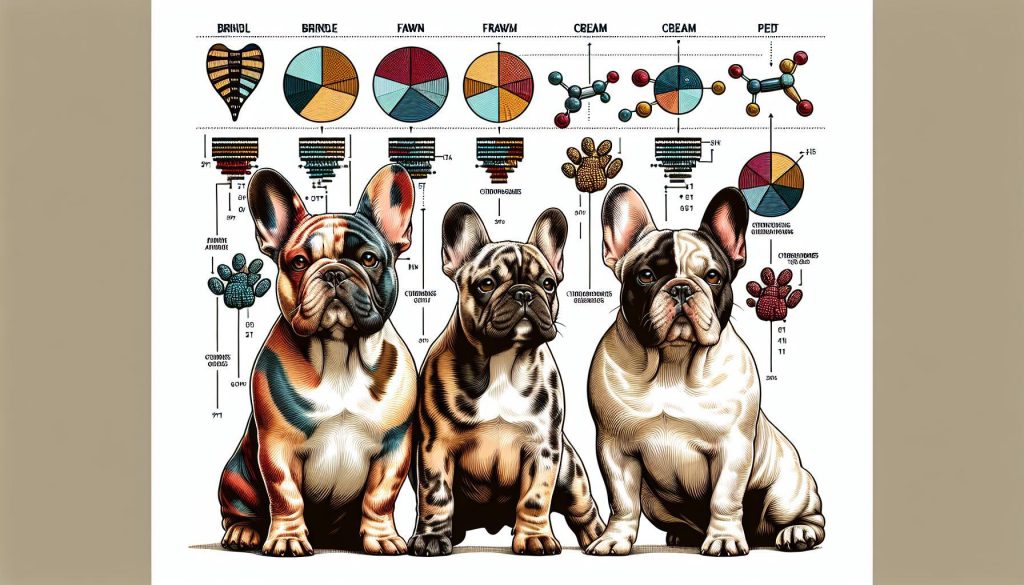About
Understanding French Bulldog Colors and Genetics
Page Contents
French Bulldogs are beloved for their charming personalities and distinctive appearance, but their variety of coat colors adds another layer of fascination for enthusiasts and breeders alike.Understanding the genetics behind these colors not only enhances appreciation for these adorable companions but also informs responsible breeding practices. From the classic brindle to the rare blue and lilac hues, each color is a result of specific genetic combinations. This article delves into the science of French Bulldog colors, unraveling the genetic codes that contribute to their diverse and captivating coats.Whether you’re a breeder or an admirer, gaining insight into these genetics enriches the appreciation of this unique breed.
Exploring French Bulldog Color Variations
- Fawn: This classic color can range from a light tan to a deep reddish hue. Fawn French Bulldogs frequently enough have a black mask, adding to their charming appearance. The fawn color is caused by a recessive gene, which means both parents must carry it for the color to appear in their offspring.
- Brindle: Known for its tiger-like stripes, brindle is a pattern rather than a color. The base color can be fawn or any other shade, with dark stripes overlaying it. This variation is quite popular and showcases the unique genetic diversity of French Bulldogs.
- Pied: Pied French Bulldogs feature a predominantly white coat with patches of another color, usually fawn or brindle. The placement and size of these patches can vary substantially,making each pied dog unique. This pattern is the result of the piebald gene.
- Blue: A dilute version of black, the blue color gives French Bulldogs a striking and rare appearance. This color results from the presence of the dilution gene, which affects the intensity of the black pigment, giving the coat a bluish tint.
- merle: A rare and controversial color pattern, merle french Bulldogs have a mottled coat with patches of blue or gray.This pattern is caused by a genetic mutation and can sometimes lead to health issues, so it’s crucial for breeders to be cautious when breeding merle dogs.
Each color variation in French Bulldogs is a testament to the intricate dance of genetics. Understanding these variations not only enhances appreciation for these charming dogs but also informs ethical breeding practices. It’s essential for breeders and enthusiasts to recognize the genetic implications of each color to ensure the health and well-being of these beloved companions.
Genetic Basics of French Bulldog Coats
French bulldogs are known for their distinctive and varied coat colors, which are determined by a complex interplay of genetics. At the core of their coat color genetics are several key genes that influence the pigmentation and patterns seen in these charming dogs. The primary genes involved include the A locus, which affects the distribution of black and red pigments, the D locus, which influences dilution of colors, and the K locus, which can modify the presence of brindle patterns.
In addition to these, the B locus plays a role in determining whether a French Bulldog will have a chocolate or liver coat, while the E locus affects the presence of a mask or the intensity of the coat color. Each of these loci can have multiple alleles, creating a wide range of potential color combinations. Such as,the presence of the recessive e allele at the E locus can lead to a cream or fawn coat,while the dominant Kbr allele at the K locus results in a brindle pattern.
- A locus: Influences black and red pigment distribution.
- D locus: Determines color dilution.
- K locus: Modifies brindle patterns.
- B locus: Affects chocolate or liver coloring.
- E locus: Controls mask presence and color intensity.
The interactions between these genetic loci are what make French Bulldog coats so diverse and unique. Understanding these genetic basics not only helps breeders make informed decisions but also allows enthusiasts to appreciate the intricate beauty of these beloved pets.
Rare and Unique French Bulldog Colors
Among the myriad of French Bulldog colors, some hues stand out due to their rarity and unique genetic makeup. These exceptional colors often require a specific combination of recessive genes, making them less common and highly sought after by enthusiasts and breeders alike.Understanding these colors not only adds to the appreciation of the breed but also highlights the captivating world of canine genetics.
**blue French bulldogs** exhibit a striking coat due to a dilution gene that affects the black pigment,resulting in a bluish-gray appearance.Similarly, the **Lilac French Bulldog** combines the blue and chocolate genes, creating a mesmerizing silvery coat with light-colored eyes. **Merle French Bulldogs** boast a unique pattern of mottled patches in various colors, thanks to the merle gene, which can also influence eye color, frequently enough resulting in one or both eyes being blue.
Other rare colors include the **Isabella French Bulldog**,which is a diluted chocolate,and the **Platinum French bulldog**,characterized by its almost white coat with hints of cream or fawn. These colors, while captivating, frequently enough come with specific health considerations, making it essential for potential owners to seek reputable breeders who prioritize the well-being of their dogs. Enthusiasts should be aware of the genetic intricacies involved in breeding these rare hues:
- **Genetic Testing**: Ensures the health and authenticity of rare colors.
- **Ethical Breeding Practices**: Critical for maintaining the breed’s health and temperament.
- **Understanding Recessive Genes**: Knowledge of genetics is key to predicting and achieving these colors.
Health implications of coat Colors
When exploring the diverse palette of french Bulldog coat colors, it’s essential to consider the potential health implications associated with certain hues. While the visual appeal of these colors is undeniable, some genetic factors linked to specific coat colors may influence the overall well-being of these adorable companions. Understanding these implications can guide potential owners in making informed decisions and ensuring the best care for their pets.
Certain coat colors, such as the striking blue or merle, are associated with genetic conditions that may affect the dog’s health. For instance, the blue coat color is often linked to a condition known as Color Dilution Alopecia (CDA), which can lead to hair loss and skin issues. Similarly, the merle pattern can be accompanied by a higher risk of auditory and ophthalmic abnormalities, notably when two merle genes are inherited. It’s crucial for breeders and owners to be aware of these risks and to undertake genetic testing and responsible breeding practices to mitigate potential health problems.
- **Blue Coats**: Associated with color Dilution Alopecia (CDA), leading to potential skin and coat issues.
- **Merle Coats**: Increased likelihood of hearing and vision problems,especially in double merles.
Responsible breeding and regular veterinary check-ups are vital in managing these health risks. Prospective owners should seek breeders who prioritize health over color rarity, ensuring the longevity and quality of life for their French Bulldogs. By understanding the genetic implications of coat colors, owners can better prepare for and address any health concerns that may arise.
Breeding considerations for Color Traits
When delving into the genetics of French Bulldog colors, it’s crucial for breeders to prioritize health and ethical practices over aesthetic preferences. **Color genetics** in French Bulldogs can be complex, with multiple genes interacting to produce the wide array of hues seen in the breed. Breeders should be knowledgeable about the genetic markers that influence color to avoid breeding dogs that may carry genes linked to health issues.
**Key considerations** include:
- **health over Color**: Some color traits, such as the merle pattern, can be associated with health problems like deafness and eye abnormalities. Responsible breeders should avoid breeding two merle dogs to prevent these potential issues.
- **Genetic Testing**: Utilize genetic testing to identify carriers of undesirable traits. This helps ensure that puppies are not only beautiful but also healthy.
- **Diversity and Ethics**: Maintaining genetic diversity within the breed is essential. Overemphasis on specific colors can lead to a limited gene pool, increasing the risk of hereditary health problems.
By adhering to these guidelines, breeders can contribute to the well-being of French Bulldogs while still appreciating the beauty of their unique color variations. Always remember that the health and temperament of the dog should take precedence over achieving a specific color.
choosing the Right Color for Your Lifestyle
When selecting a French Bulldog, color can be more than just an aesthetic choice; it can also align with your lifestyle and personal preferences. **Consider your habitat and daily routine** when choosing the perfect hue for your new companion. For instance, if you live in a sunny, outdoor-kind area, lighter-colored french Bulldogs, such as cream or fawn, may be more suitable as they reflect sunlight better, potentially keeping them cooler during warm weather.
**Maintenance and cleaning** are also factors to consider. Darker colors, such as brindle or black, might be more forgiving when it comes to hiding dirt and stains, which can be a boon if your pup loves to play outside or if you have a busy household. On the other hand, lighter colors might require more frequent grooming to maintain their pristine appearance.
- **Active lifestyle**: Opt for colors that are easy to maintain and can withstand the elements.
- **Indoor living**: Choose a color that complements your home decor or personal style.
- **Family with children**: Consider colors that are less prone to showing dirt from playtime.
Ultimately, the right color should resonate with your personal taste and fit seamlessly into your lifestyle, ensuring a harmonious relationship with your new furry friend.
Caring for Your French Bulldog’s Coat
When it comes to maintaining the health and vibrancy of your French Bulldog’s coat, understanding the unique needs of their fur is essential. French Bulldogs have a short, smooth coat that requires regular care to keep it looking its best. Here are some tips to ensure your Frenchie’s coat remains healthy and shiny:
- Regular Brushing: Despite their short hair, French Bulldogs benefit from weekly brushing. This helps remove loose hairs, reduces shedding, and promotes healthy skin by distributing natural oils.
- Bathing Routine: Bathe your Frenchie once a month or as needed with a gentle, dog-friendly shampoo. Over-bathing can strip their coat of essential oils, leading to dryness and irritation.
- Nutrition: A balanced diet rich in omega-3 and omega-6 fatty acids contributes significantly to a healthy coat. Consider adding fish oil supplements if recommended by your vet.
Along with these care tips, pay attention to any changes in your French Bulldog’s coat, such as excessive shedding or bald spots, as these could be signs of underlying health issues. Regular check-ups with your vet will help ensure any concerns are addressed promptly, keeping your furry friend’s coat in top condition.
In Conclusion
understanding the diverse colors and genetics of French Bulldogs not only enhances our appreciation for these charming dogs but also aids in responsible breeding practices.By recognizing the genetic factors that influence their coat colors, enthusiasts and breeders can make informed decisions that prioritize the health and well-being of these beloved pets. Whether you’re a prospective owner or a seasoned breeder, a deeper knowledge of French Bulldog genetics enriches the bond with these delightful companions. Embrace the vibrant palette of French Bulldog colors,and celebrate the unique beauty each one brings.

